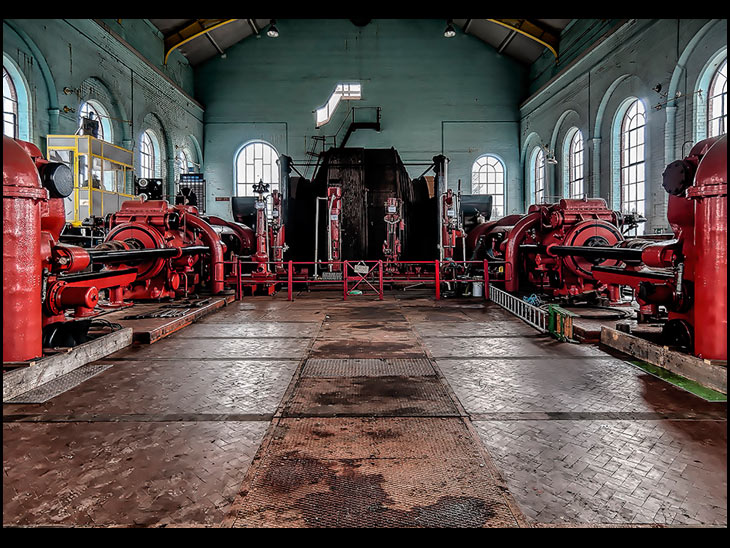Photo-a-Day (Thursday, 10th October, 2013)
Winding Room

Photo: Jeff Haydock (HDR Nikon D90, Tokina 12-24)
Great photo of probably a triple expansion steam engine, as Cullie always growls at the diesel electrics I give this a double growl. Is this still live???
Wow what a powerful picture...lots of history I bet...well done Jeff...cheers!!!
Jeff; I`ve looked at Astley Green Colliery Museum website :-
http://www.agcm.org.uk/
Looked at video on :-
http://www.youtube.com/watch?v=X9h9kMoyQi4
but am no wiser in finding out if this 3,300 HP winding engine built in 1912 by Yates and Thom Ltd., Blackburn is in working order.
Another interesting website :-
http://www.aditnow.co.uk/documents/Astley-Green-Coal-Mine/ASTENGIN.pdf
After typing the above, have found
video :-
http://www.youtube.com/watch?v=ecgZWatMVpU
which shows this engine running.
a good bit of history being maintained. it looks massive
The engine is in excellent condition and is very well maintained. It does not run unfortunately. The colliery houses quite a few interesting machines and engines and is well visited. The colliery is a constant work in progress and it is free to enter. They ask for donations from the visitors to help maintain it - but you are never pushed or feel pressured to make them. It is a great place for photographers!
Kath. If you think that's impressive (and it is), go take a look in Trencherfield Mill - and tha one runs too!
Would there have been anything in the central area originally?
Good photo by the way, must visit.
Pass often on the E. Lancs Rd
Beautiful shot, very nice
Paula, it is unlikely that the central area contained anything else. By leaving it free, there is working room during maintenance, and repair, possibly bringing in lifting equipment as and when required.
For something similar at Trencherfield Mill see:-
http://www.wiganworld.co.uk/album/photo.php?opt=3&id=803&gallery=Trencherfield+Mill&offset=0
The engine does run albeit on compressed air - still a beautiful sight to see in motion.
Thanks Neil, have looked at the Trencherfield pic also.
Fantastic
Marcus; The Trencherfield engine is 2,500HP with 25"dia.HP and 44"dia.LP cylinders, 5ft stroke. Drum 26ft dia. 68rpm. This engine runs at a constant speed.
The Astley Green engine is 3,300HP with 35"dia.HP and 60"dia.LP cylinders, 6ft stroke. Drum 27ft/17ft dia.57rpm. From start to finish the "winding cycle" takes barely two minutes, 8 tons of coal and about 50 tons of rope, cages and tubs have all moved through half a mile of shaft, accelerated to nearly 60 miles per
hour in about 40 seconds and has rapidly decelerated again - to be repeated over and over again, 30 times an hour, 240 times a shift... every day.
Eckersleys Mill engine, was bigger than both of 'em
Ken R; Extract from ;-
http://www.aditnow.co.uk/documents/Astley-Green-Coal-Mine/ASTENGIN.pdf
The Astley No.1 Winding Engine is a twin (or double) tandem compound, that is, the steam was used
twice, firstly in the high pressure cylinders 35 inches in diameter where it entered at the full boiler
pressure of 160 p.s.i, here it partially expanded, driving the piston in the cylinder and was then
exhausted to a receiver beneath the floor. To ensure that there was always a supply of low pressure
steam at about 60 p.s.i., the exhaust steam was mixed with a supply of high pressure steam via a reducing valve. This low pressure steam then entered the low pressure cylinders 60 inches in diameter where it was again expanded to drive the larger pistons before being exhausted to external condensers. Thus there were effectively two engines each with their high and low pressure cylinders connected in tandem. Unlike a mill engine, which was intended to run at constant speed and therefore could work, if
required on only one "side", a winding engine needed the torque from both sides so that it could start with the drum and cranks in any position. For the same reason the cranks were set at right angles to one another. The power output of the winder was at least 3,000 to 3,500 b.h.p., these being official figures, which were probably exceeded from time to time.
Thanks for all the info on the engine, very interesting and for your comments and viewings.
Art; There`s very little info on Internet of Eckersley`s Mill engine to be had.
There are 3 photo`s in Album, Work, Eckersley`s Mill.
1st photo on Page 1 states flywheel is largest in country 30ft dia. Engine had a stroke of 6ft and was 1600HP.
2nd photo on Page 1 gives same info but the one comment :-
Comments by John, 10th November 2011
Atlas mill no'6 in Bolton, and Brooklands mill in Leigh had 32ft diameter flywheel, unbelievable size.
Photo on page 2 at end of 3rd row states engine is 2600HP.
So the Astley Green engine is the most powerful of the three.
If I quoted from google, I would accredit it.
I remember Eckersleys mill engine very well. Also, as for power, a winding engine lifting many tons of rope, cage & minerals, NEEDS more power than than one driving a flywheel, operating overhead shafting driven machines.
The flywheel on "Ecks" engine weighed 100 tons, a real "biggie"